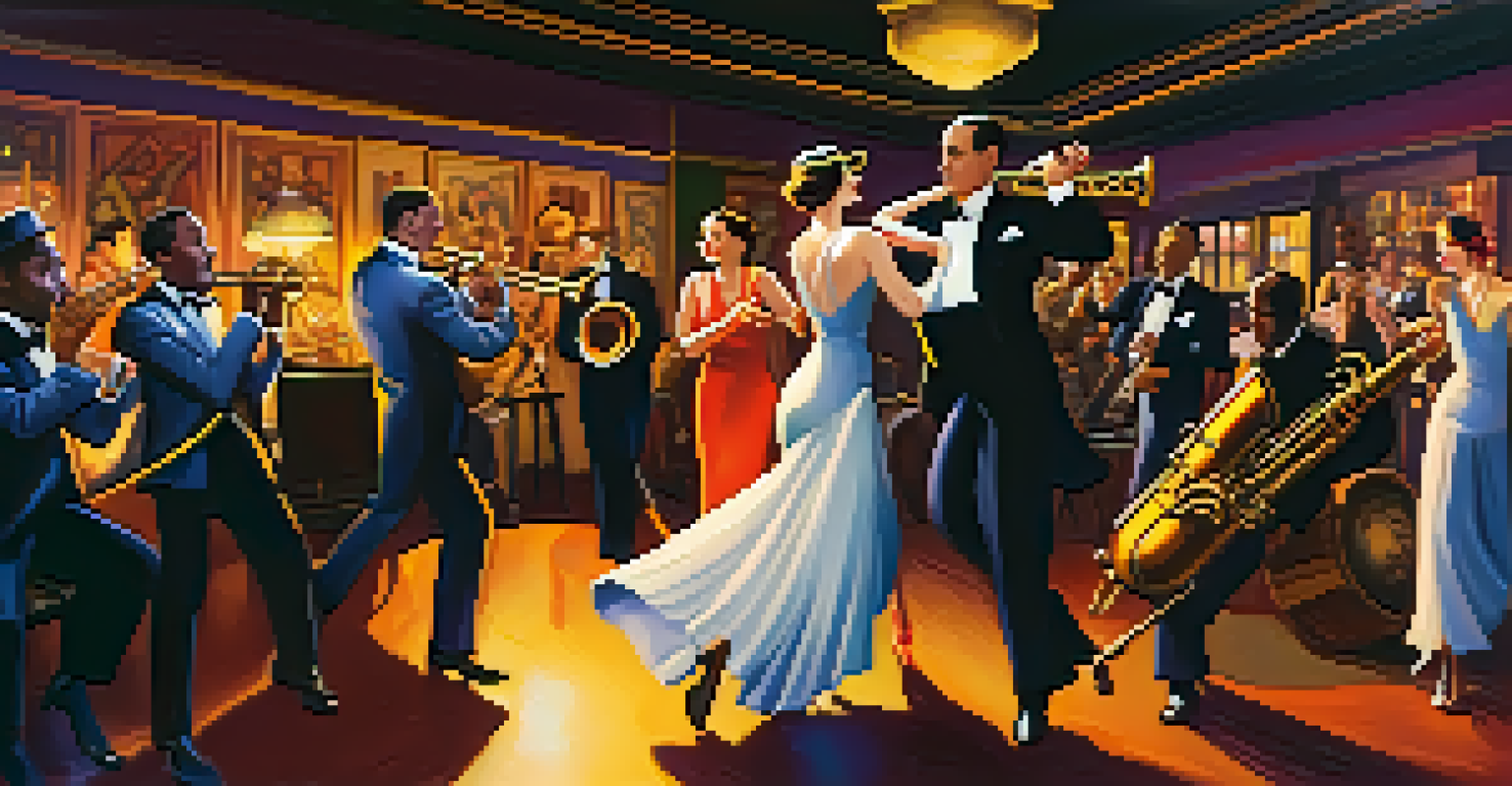The Dance of Life: Metaphors in Classic Literature

Introduction to Metaphors: Life as a Dance
In literature, metaphors often bring complex ideas to life, and one of the most evocative is the metaphor of dance. Just as dance involves rhythm, movement, and expression, life itself can be seen as a beautifully choreographed performance. This metaphor not only highlights the elegance of human experience but also emphasizes the interplay of emotions and actions. By exploring how classic literature employs this metaphor, we can gain deeper insights into the human condition.
Life is like a dance; it’s not about how you move but how you feel while you move.
Dance, in its many forms, serves as a powerful symbol of the ups and downs we encounter throughout our lives. It showcases the fluidity of existence, where moments of joy and sorrow intertwine seamlessly. Through the lens of dance, authors can communicate themes of love, loss, and resilience, making their narratives resonate on a profoundly human level. As we delve into classic works, we’ll uncover how various authors have embraced this metaphor.
Ultimately, understanding life as a dance allows readers to appreciate the intricate tapestry of experiences that shape our journeys. It invites us to consider how we navigate our own steps in this grand choreography. In the following sections, we will explore specific examples of dance metaphors in classic literature and how they illuminate our understanding of life's complexities.
Shakespeare: The Dance of Fate in 'Romeo and Juliet'
William Shakespeare masterfully employs the dance metaphor in 'Romeo and Juliet,' particularly through the themes of fate and choice. The characters' lives can be seen as a delicate ballet, where each decision leads to a new step in an inevitable tragic performance. For instance, the famous ballroom scene sets the stage for the fateful encounter between Romeo and Juliet, highlighting how chance and destiny are intertwined.

Throughout the play, the metaphor of dance serves to illustrate the tension between free will and predetermined fate. Just like dancers following a choreographed routine, the characters are caught in a sequence of events that they cannot escape. This creates a poignant commentary on the nature of love and the consequences of choices made in the heat of passion.
Metaphors Illuminate Human Experience
Dance metaphors in literature enhance our understanding of complex themes such as love, loss, and resilience.
The tragic ending of 'Romeo and Juliet' can be likened to a final, heartbreaking bow at the end of a performance. Their lives, like a dance, are filled with beauty and intensity, but ultimately lead to an inescapable conclusion. Shakespeare’s use of dance as a metaphor beautifully encapsulates the idea that life is a series of movements, often beyond our control.
The Waltz of Nature in Wordsworth's Poetry
In the works of William Wordsworth, nature often takes on the role of a graceful partner in a dance, illustrating the harmony between humanity and the natural world. Wordsworth’s poetry reflects this waltz, where the beauty of nature inspires deep emotional responses. For instance, in 'I Wandered Lonely as a Cloud,' the imagery of dancing daffodils conveys a sense of joy and connection to the earth.
We are all dancers in the game of life, learning the steps as we go along.
This metaphor of dance highlights the rhythm of life and the cyclical nature of seasons. Just as dancers move in sync with music, so too does nature follow its own patterns, reminding us of the beauty inherent in change. Wordsworth's portrayal of nature as a dance partner encourages readers to appreciate the simple pleasures and the fleeting moments that life offers.
Through this lens, Wordsworth invites us to engage in our own dance with nature, fostering a sense of unity and peace. His poetry serves as a reminder that life, much like a dance, is about finding balance and joy amidst the chaos. The metaphor of dance enriches our understanding of the connection between humans and the natural world, making it an essential theme in his work.
Hemingway: The Tango of War and Peace
Ernest Hemingway's writings often reflect the tango of war and peace, illustrating the complexities of human emotions in conflict. In works like 'A Farewell to Arms,' the interplay between love and the brutality of war creates a dance filled with tension and longing. Here, the characters navigate their tumultuous relationship against the backdrop of a world at war, embodying the struggle for connection amidst chaos.
The metaphor of dance becomes particularly poignant as it captures the delicate balance between hope and despair. Just as a tango requires precise movements and trust between partners, so too do the characters in Hemingway's narratives rely on their emotional connections to survive. Their journeys are marked by passion and heartache, mirroring the unpredictable rhythms of life.
Shakespeare and Fate's Dance
In 'Romeo and Juliet,' Shakespeare uses dance to symbolize the interplay between free will and predetermined fate.
Ultimately, Hemingway's exploration of this dance highlights the resilience of the human spirit. Even in the darkest moments, the desire for love and understanding persists, much like the enduring nature of dance itself. This metaphor serves to remind readers that life, with all its complexities, is a performance where we must learn to navigate our steps with grace.
Fitzgerald: The Jazz of the American Dream
F. Scott Fitzgerald captures the essence of the American Dream through the metaphor of jazz in 'The Great Gatsby.' The vibrant, improvisational nature of jazz parallels the characters' pursuit of wealth, love, and status. Gatsby's lavish parties can be seen as a dance of excess, where the rhythms of ambition and desire clash with the stark reality of unattainable dreams.
The lively music of the Jazz Age serves as both a backdrop and a catalyst for the characters' interactions, highlighting the tension between appearances and reality. Just as jazz musicians improvise, the characters navigate their lives in a world filled with uncertainty and change. This metaphor illustrates the idea that life is often a spontaneous performance, with moments of brilliance interspersed with dissonance.
Ultimately, Fitzgerald's use of the jazz metaphor invites readers to reflect on the complexities of aspiration and identity in a rapidly changing society. The dance of life, filled with both exhilarating highs and heartbreaking lows, mirrors the unpredictability of the American Dream. Through this lens, Fitzgerald encourages us to consider the true cost of our pursuits and the music that accompanies our journeys.
The Waltz of Time in Virginia Woolf's Novels
Virginia Woolf's novels often explore the passage of time through the metaphor of dance, highlighting the fluidity of human experience. In works like 'Mrs. Dalloway,' time is depicted as a waltz, where past and present intertwine, creating a rich tapestry of memory and emotion. Woolf's narrative style reflects this rhythm, allowing readers to experience moments of clarity amidst the chaos of life.
The dance of time in Woolf's work emphasizes the beauty of fleeting moments and the importance of living in the present. Just as a waltz requires awareness and connection between partners, Woolf encourages readers to engage with their own experiences fully. This metaphor serves as a reminder that life is a series of movements, each one significant in its own right.
Woolf's Dance of Time
Virginia Woolf's novels depict time as a waltz, emphasizing the beauty of fleeting moments and the importance of living in the present.
Through this dance of time, Woolf invites us to reflect on our personal journeys and the connections we share with others. Her exploration of memory and existence resonates with the idea that while time may be fleeting, the moments we cherish are eternal. In this way, Woolf's use of the dance metaphor enriches our understanding of life's complexities and the beauty within.
Conclusion: Embracing the Dance of Life
As we conclude our exploration of dance metaphors in classic literature, it becomes clear that these literary devices serve as powerful tools for understanding the human experience. From Shakespeare to Woolf, authors have embraced the dance metaphor to convey themes of love, loss, and resilience. Each interpretation offers a unique perspective on the intricate choreography of life.
By viewing life as a dance, we can appreciate the beauty in our own movements and the connections we forge along the way. This metaphor invites us to engage with our experiences, recognizing that every step, whether joyful or challenging, contributes to our personal narrative. It encourages us to find grace in the chaos and celebrate the rhythm of existence.

Ultimately, the dance of life is a universal theme that resonates across cultures and time periods. As we reflect on these classic works, let us carry forward the lessons learned and embrace our own dance with authenticity and passion. After all, life itself is the most enchanting performance of all.